Spruce spider mite species (Oligonychus ununguis) are found in Christmas tree farms as well as landscapes & nurseries in the New Jersey region. The late weeks of September & early weeks of October are transition periods for this cool season mite. With the arrival of autumn & cooler temperatures, the spruce spider mites begin to “wake up” from their summer dormancy & will be observed feeding & laying eggs. Observations this past week in Christmas tree farms have shown increased activities of the spruce spider mites. This spider mite species will feed exclusively on various conifers including spruce, fir, Douglas-fir, hemlock, Cryptomeria, arborvitae, false-cypress, pine, & juniper.
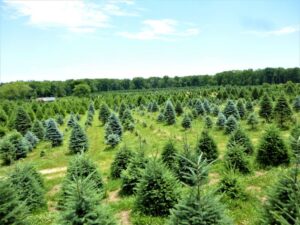
This Christmas tree farm is an ideal site for potential spruce spider mite infestations. (Photo Credit: Steven K. Rettke, Rutgers Coop. Ext.)
Spruce Spider Mites are Now Active:
Spruce spider mite movements at a Christmas tree farm in Monmouth County were recently observed & as we move into the early weeks of October, significant feeding will increasingly begin to take place. Some pest managers erroneously assume that all spider mite species thrive in hot & dry weather conditions. It is important to remember that spider mite pests found within Christmas tree farms as well as landscapes & nurseries can be divided into the cool season & warm season types. Although all spider mites will indeed thrive best in dry conditions, the seasonal temperatures determine when the distinct species proliferate & cause feeding symptoms.
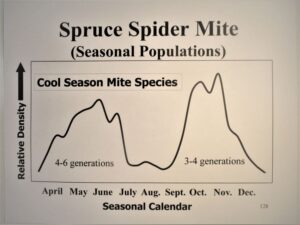
This graph shows the seasonal relative populations of the spruce spider mite. (Graph Drawing Credit: Steven K. Rettke, Rutgers Coop. Ext,)
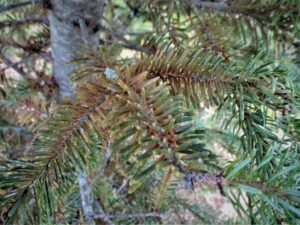
Active mites on a Balsam fir. Spruce spider mites could potentially build-up this fall on infested conifers & damage the 2022 needle growth.
Feeding Symptoms:
Spruce spider mites create stippling symptoms when they use their piercing & sucking mouthparts to feed within individual plant cells. Needle discoloration occurs when tissue cell contents, including green chlorophyll, are removed. If feeding damage to the 2021 foliage growth was observed during the summer months, then this occurred during the spring & fall months (fall ‘21 &/or spring ’22 seasons). The new 2022 twig needle growth may not yet show significant feeding symptoms. Some Christmas tree managers may not realize considerable damage to conifers can occur during the upcoming fall months.
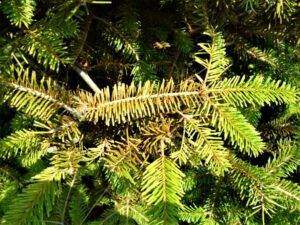
A Frasier fir during mid-summer showing spider mite symptoms on previous years needle growth. Needles of new twig growth still appear clean. (Photo Credit: Steven K. Rettke, Rutgers Coop. Ext.)
Additional photographs below show older spider mite symptoms on spruce & fir species. Observe the feeding damage on previously infested needle growth. The leaf stippling symptoms on the older, inner growth are apparent. The spruce mites fed on the older 2021 growth of these trees during last fall of ’21 &/or this past spring. When the newer, outer 2022 growth emerged during the spring, the mites did not have the opportunity to do much feeding damage to needles before they became dormant in June. For example, when June temperatures began to reach highs of 85° F. & above, then this signaled the spruce spider mites to begin to move into the summer dormant stage. Furthermore, the new needles of conifers often contain toxins that deter spider mite feeding. The toxins dissipate after the needle tissues mature.
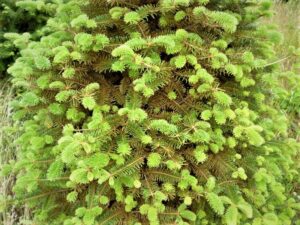
Older, interior needle growth on this Frasier fir show significant feeding symptoms from past spruce spider mite infestations. During the summer months there are no apparent symptoms on new needle growth. (Photo Credit: Steven K. Rettke, Rutgers Coop. Ext.)
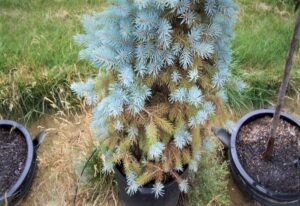
This Colorado blue spruce shows dramatic spruce spider mite feeding symptoms on the older, inner needles. As the fall weeks progress, this cool season mite will begin to feed & damage the new, outer blue needles. (Photo Credit: Steven K. Rettke, Rutgers Coop. Ext.)
Monitoring for Active Signs:
Monitor now for the resumption of mite activity on previously injured host plants by using a beating tray & at least a 10X hand-lens. When eggs are freshly laid, they have a clear appearance, but as the embryos develop the eggs take on a maple syrup or reddish-brown coloration. Observing with a 10X hand lens the number of eggs on the infested plant can foretell future population levels. Also, do not forget about the “sophisticated technology” of using a white beating tray to determine relative numbers of active mites. When 10 or more spider mites are consistently tapped from branches & predators are low, then miticide treatments may be recommended.
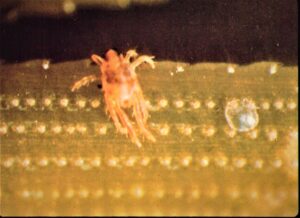
Close-up of a spider mite adult & recently laid egg on a pine needle. The parallel white dots are needle stomates. (Photo Credit: Cornell Univ. Press)

A white “beating tray” shows the spider mite blood streaks spread across the paper. Thresholds are reached when 10 or more spider mites are consistently knocked off branches with each beat. (Photo Credit: Steven K. Rettke, Rutgers Coop. Ext.)
This fall, the emerging spruce spider mites can potentially continue to feed until the late weeks of November or even early December. Some of the most damaging symptoms can occur from mid-October through November. The final fall spruce mite generation will lay overwintering eggs when freezing temperatures begin to occur. These eggs can still be mostly clear or may have a reddish-brown coloration. With a 10X hand lens, the eggs are easily observed at the base of needles or on twigs. The spruce spider mite can produce 3-4 generations during the fall season in NJ.
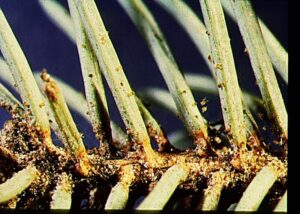
Active spruce spider mites with eggs & white cast skins or egg shells at the base of spruce needles & twig. (Photo Credit: Ohio State Coop. Ext.)
Spruce Spider Mite Controls:
During the summer months, miticides against this cool season species will often be delayed until the fall when full activity & new egg hatch resumes. Horticultural oils can be applied to target eggs during the summer or winter seasons, but only if counts are high. Miticide treatments should be concentrated during active periods from March through June & September through November. There are a couple dozen or more miticides labeled for use against spruce spider mites. Some of the reduced-risk miticides available include acequinocyl, bifenazate, Spinosad, & spiromesifen.
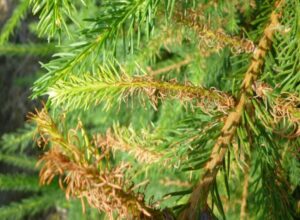
A summer horticultural oil caused phytotoxicity damage to this Frasier fir. The oil was incorrectly applied when humidity & temperature levels were too high. (Photo Credit: Steven K. Rettke, Rutgers Coop. Ext.)

